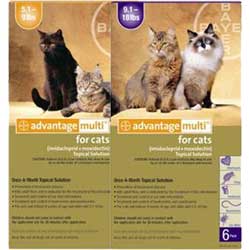Advantage Multi for Cats
+ Save on each recurring order!
Price Match Guarantee
- Once-A-Month Topical Solution for Cats (imidacloprid +moxidectin)
- Prevention of heartworm disease
- Kills adult fleas and is indicated for the treatment of flea infestations
- Treatment and control of ear mite infestations, hookworms and roundworms
Description
Advantage Multi® for Cats (imidacloprid + moxidectin) Topical Solution
New prescription-only Advantage Multi for Cats combines the proven-effective flea control of Advantage®, which has been trusted by veterinarians and their clients for more than 10 years, with a 100-percent effective preventative for heartworm disease and highly effective treatment and control of intestinal nematodes (hookworms and roundworms) all in one convenient, monthly topical solution. Advantage Multi for Cats also treats and controls ear mite infestations.
Benefits
- 100 percent effective at preventing heartworm disease caused by Dirofilaria immitis.
- Up to 100 percent effective treatment and control of hookworm infections caused by Ancylostoma tubaeforme (adults, immature adults, and fourth stage larvae) and roundworm infections caused by Toxocara cati (adults and fourth stage larvae).
- Proven effective (up to 99.6 percent) treatment and control of ear mite (Otodectes cynotis) infestations.
- Safe and effective, when used topically as directed, for cats and kittens that are at least nine weeks of age and that weigh at least two pounds.
- Once-a-month, ready-to-use topical solution packaged in six, single-dose applicator tubes available for cats weighing 5.1 to 9 pounds and 9.1 to 18 pounds.
Ingredients
The two main ingredients in Advantage Multi for Cats are Moxidectin and Imidacloprid. Moxidectin acts systemically to target endoparasites. It is absorbed for heartworm prevention and intestinal nematode control for the whole month. Imidacloprid acts topically to target ectoparasites. It is spread across the skin surface, and into the superficial lipid level for month-long flea kill.Directions
Do not apply to irritated skin
| Cat (lb.) | Advantage Multi For Cats | Volume (mL) | Imidacloprid (mg) | Moxidectin (mg) |
| 2.5 | Advantage Multi 5 | 0.23 | 23 | 2.3 |
| 5.1-9 | Advantage Multi 9 | 0.4 | 40 | 4 |
| 9.1-18* | Advantage Multi 18 | 0.8 | 80 | 8 |
| *Cats over 18 lbs. should be treated with the appropriate combination of Advantage Multi for Cats tubes. | ||||
- Remove one dose applicator tube from the package. As specified in the following table, administer the entire contents of the Advantage Multi for Cats tube that correctly corresponds with the body weight of the cat.
- While holding the tube in an upright position, remove the cap from the tube.
- Turn the cap over and push the other end of cap onto the tip of the tube.
- Twist the cap to break the seal and then remove cap from the tube.
- Part the hair on the back of the cat's neck at the base of the head, until the skin is visible. Place the top of the tube on the skin and apply the entire contents directly on the exposed skin. Lift tube away from skin before releasing pressure on tube.
Do not get this product in the cat's mouth or eyes or allow the cat to lick the application site for 30 minutes. Treatment at the base of the head will minimize the opportunity for ingestion by grooming. In households with multiple pets, keep animal separated to prevent licking of the application site.
Stiff, matted hair or a damp, oily appearance of the hair may be observed at the application site on some cats. This is temporary and does not affect the safety and effectiveness of the product.
Useful Information
In addition to killing fleas and treating and controlling ear mites, Advantage Multi® for Cats also treats and controls roundworms and hookworms, and prevents heartworm disease in cats. This broad-spectrum protection is critically important to your cat's health because:
- Heartworm disease can pose serious health risks for cats, like respiratory disease and even sudden death. Even indoor-only cats are at risk for heartworm disease. Since there are no products approved to kill adult heartworms in cats, heartworm prevention is key.
- Hookworms can be ingested or penetrate your cat's skin. When they're fully grown, hookworms attach to the intestinal wall, and can leave bleeding ulcers behind.
Heartworm Prevention
For prevention of heartworm disease, Advantage Multi for Cats should be administered at one-month intervals. Advantage Multi for Cats may be administered year-around or at a minimum should start one month before the first expected exposure to mosquitoes and should continue at monthly intervals until one month after the last exposure to mosquitoes. If a dose is missed and a 30-day interval between doses is exceeded, administer Advantage Multi for Cats immediately and resume the monthly dosing schedule. When replacing another heartworm preventative product in a heart-worm prevention program, the first treatment with Advantage Multi for Cats should be given within one month of the last dose of the former medication. At the discretion of the veterinarian, cats older than 6 months of age may be tested to deter-mine the presence of existing heartworm infection before treatment with Advantage Multi for Cats (See ADVERSE REAC-TIONS - Post-Approval Experience).
Flea Treatment
For the treatment of flea infestations, Advantage Multi for Cats should be administered at one-month intervals. If the cat is already infested with fleas when the first dose of Advantage Multi for Cats is administered, adult fleas on the cat will be killed. However, re-infestation from the emergence of pre-existing pupae in the environment may continue to occur for six weeks or longer after treatment is initiated. Cats treated with imidacloprid, including those with pre-existing flea allergy dermatitis have shown clinical improvement as a direct result of elimination of fleas from the cat.
Ear Mite Treatment
For the treatment of ear mites (Otodectes cynotis), Advantage Multi for Cats should be administered once as a single topical dose. Monthly use of Advantage Multi for Cats will control any subsequent ear mite infestation.
Intestinal Nematode Treatment
For the treatment and control of intestinal hookworm infections caused by Ancylostomatubaeforme (adults, immature adults and fourth stage larvae) and roundworm infections caused by Toxocara cati (adults and fourth stage larvae), Advantage Multi for Cats should be administered once as a single topical dose
Animal Safety
Studies in Kittens
Advantage Multi for Cats was topically applied at 0, 1, 3, and 5X the maximum dose to 48 healthy 9-week-old kittens on days 0, 28, and 56. Lethargy was observed in 1 kitten from the 3X group and 1 from the 5X group on the day after initial treatment; the kitten from the 3X group was also disoriented and ataxic. One kitten from the 3X group had a slow pupillary light response two days after treatment and one had tremors the day after treatment. Hyper salivation was seen in one kitten from the 5X group approximately six hours post-treatment. One kitten from the 3X group was scratching at the treatment site 2 days after treatment. Slight cough was noted in 7 different kittens (2-0X,2-1X, and 3-5X) during the 13-day period following the first treatment. Histopathology showed granulomatous inflammation at the treatment site in three 1X kittens. Causal relationship to the drug could not be determined. Pulmonary inflammation (1-5X) and lymphoid hyperplasia (2-1X, 4-3X) were seen in treated kittens. In a second study, Advantage Multi for Cats was topically applied at 0, 1.7, 5.2 and 8.7X the maximum dose to 48 healthy 9-week-old kittens every two weeks for 6 doses. One kitten in the 8.7X group apparently ingested an unknown amount of the drug and developed the following clinical signs prior to euthanasia: mydriasis, salivation, depression, vomiting, unsteadiness, rapid to slow to difficult breathing, poor pupillary response, generalized tremors, inability to move, and nystagmus. Two kittens in the 5.2X group developed mydriasis, salivation, depression, squinting, and poor appetite. A kitten in the 1.7X group developed mydriasis.
Dose Tolerance Study
Eight healthy juvenile cats were topically dosed with a single application of Advantage Multi for Cats at 10 times the recommended dose volume. Mild, transient hyper salivation occurred in two of the cats.
Oral Study in Cats
The oral safety of Advantage Multi for Cats was tested in case of accidental oral ingestion. The maximum topical dose was orally administered to twelve healthy 9-week-old kittens. Hyper salivation (8 of 12 kittens) and vomiting (12of 12 kittens) were observed immediately post-treatment. Tremors developed in one kitten within 1 hour, resolving without treatment within the next hour. All 12 kittens were either anorexic or had decreased appetite for at least 1 day following treatment. In 3 kittens, the anorexia or decreased appetite continued into the second week following treatment. There was a post-treatment loss of body weight in treated kittens compared to control kittens. In a pilot safety study using kittens younger in age and lighter in weight than allowed by product labeling, an 8-week old kitten weighing 0.6 kg orally received 2X of the label topical dose (0.46 mL/kg). Immediately after dosing, it vomited, had labored breathing and slight tremors. Within 4 hours, it was normal, but was found dead on day 6. Necropsy could not determine the cause of death.
Study in Heartworm Positive Cats
Young adult cats were inoculated subcutaneously with third-stage D. immitislarvae. At 243-245 days post-infection, immunoserology and echocardiography were performed to identify cats with adult heartworm burdens similar to naturally-acquired infections. Two groups were treated topically with either Advantage Multi for Cats at the label dose or placebo, once every 28 days, for three consecutive treatments. A third group was treated topically, once, with Advantage Multi for Cats at 5X the label dose. Sporadic vomiting and labored breathing related to heartworm burden were observed in the treatment and control groups. There was no difference between treatment groups in the numbers ofadult D.immitis recovered at study conclusion. No adverse reactions were associated with the topical application of Advantage Multi for Cats to experimentally heartworm-infected cats.
Precautions
Do not dispense dose applicator tubes without complete safety and administration information. Avoid oral ingestion. The safety of Advantage Multi for Cats has not been established in breeding, pregnant, or lactating cats or ferrets. The effectiveness of Advantage Multi for Cats against heartworm infections (D. immitis) after bathing has not been evaluated in cats. Use of this product in geriatric pets with subclinical conditions has not been adequately studied. Several otherwise healthy, thin geriatric cats experienced prolonged lethargy and sleepiness after using this drug.







